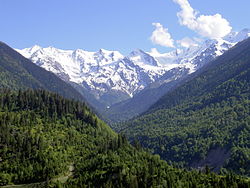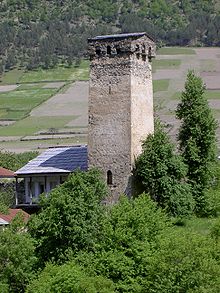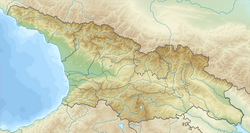Svaneti
Svaneti
სვანეთი | |
|---|---|
 The historic region of Svaneti in Georgia | |
| Coordinates: 42°54′59″N 43°00′41″E / 42.91639°N 43.01139°E | |
| Country | |
| Mkhare | Racha-Lechkhumi and Kvemo Svaneti Samegrelo-Zemo Svaneti Abkhazia |
| Capital | Mestia, Lentekhi |
| Area | |
| • Total | 5,776.4 km2 (2,230.3 sq mi) |
| Population | |
| • Total | 23,000 |
| • Density | 4.0/km2 (10/sq mi) |
| UNESCO World Heritage Site | |
|---|---|
 Chazhashi in 2016 | |
| Location | Chazhashi |
| Criteria | Cultural: iv, v |
| Reference | 709 |
| Inscription | 1996 (20th Session) |
| Area | 1.06 ha |
| Buffer zone | 19.16 ha |
| Coordinates | 42°54′27″N 43°0′39″E / 42.90750°N 43.01083°E |
Svaneti or Svanetia (Svan: შუ̂ან, ლემშუ̂ანიერა shwan, lemshwaniera, Suania in ancient sources; Georgian: სვანეთი Svaneti) is a historic province in the northwestern part of Georgia. Running along the Greater Caucasus range, Svaneti is one of the most mountainous regions of Georgia. It is largely inhabited by the Svans, an ethnic subgroup of Georgians.
Geography
Situated on the southern slopes of the central
Svaneti has two parts corresponding to two inhabited valleys:
- Upper Svaneti (Zemo Svaneti) on the upper Inguri River; administratively part of Samegrelo-Zemo Svaneti; main town Mestia
- Lower Svaneti (Kvemo Svaneti) on the upper Tskhenistsqali River; administratively part of Racha-Lechkhumi and Kvemo Svaneti; main town Lentekhi
They are separated by the

Landscape

The landscape of Svaneti is dominated by mountains that are separated by deep gorges. Most of the region which lies below 1,800 meters (5,904 ft) above sea level is covered by mixed and
Climate
The climate of Svaneti is humid and is influenced by the air masses coming in from the
History


The Svans are usually identified with the Soanes mentioned by
The marauding
Part of the Russian governorate of Kutais, Svanetia was divided into two raions (districts) — Mestia (former Sethi) and Lentekhi — under the Soviet rule. The unsuccessful anti-Soviet Svaneti uprising took place in the region in 1921.

In 1987,
Population

The Svans, the indigenous population of Svanetia, are an ethnic subgroup of the
Typically bilingual, they use both
Culture and tourism
Svanetia is known for its architectural treasures[
Svan songs and dances are notable cultural traditions. Svanetia boasts arguably the most archaic three-part polyphonic singing. Most of their songs are connected to round dances, are performed very loudly and are full of dissonant chords.[6]
See also
- Samegrelo-Zemo Svaneti
- Racha-Lechkhumi and Kvemo Svaneti
- Kodori Valley
- Dadeshkeliani
- Ushguli
- Gelovani
References
- ^ Friedrich Bodenstedt, Die Voelker Des Kaukasus..., 1848, page 69
- ^ ISBN 978-0-19-866277-8.
- ^ Trier, Tom & Turashvili, Medea (2007): Resettlement of Ecologically Displaced Persons - Solution of a Problem or Creation of a New? Eco-Migration in Georgia 1981–2006. ECMI Monograph #6. "Archived copy" (PDF). Archived from the original (PDF) on 2010-06-02. Retrieved 2010-03-23.
{{cite web}}: CS1 maint: archived copy as title (link) - ^ President Hails Anti-Crime Operation in Svaneti Civil Georgia, Tbilisi, 24 March 2004
- ^ "Upper Svaneti". UNESCO World Heritage Centre. United Nations Educational, Scientific, and Cultural Organization. Retrieved 5 Mar 2022.
- ^ Jordania, J. (2015). "Choral Singing in Human Culture and Evolution", Lambert Academic Publishers, Chapter "Traditional Polyphony in Svaneti", Pg. 120-123
External links
 Svaneti travel guide from Wikivoyage
Svaneti travel guide from Wikivoyage- Frescos and icons from Svanetia. (in German)
- Svan language. Encyclopædia Britannica.
- Svan language. TITUS.
- Svaneti trek GPS coordinates, GPS maps and information links.





